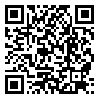Volume 5, Issue 4 (october 2021)
AOH 2021, 5(4): 1125-1130 |
Back to browse issues page
Download citation:
BibTeX | RIS | EndNote | Medlars | ProCite | Reference Manager | RefWorks
Send citation to:



BibTeX | RIS | EndNote | Medlars | ProCite | Reference Manager | RefWorks
Send citation to:
Askari Majdabadi M, mousavi S M, Yazdani rad S, parihadi S, hosseini S S, beiruti M, et al . The Effects of Nurses' Personal and Professional Characteristics on Needle Stick Injuries. AOH 2021; 5 (4) :1125-1130
URL: http://aoh.ssu.ac.ir/article-1-262-en.html
URL: http://aoh.ssu.ac.ir/article-1-262-en.html
Masoud Askari Majdabadi1 

 , Seyed mahdi Mousavi2
, Seyed mahdi Mousavi2 

 , Saeid Yazdani rad *3
, Saeid Yazdani rad *3 

 , Sogand Parihadi4
, Sogand Parihadi4 

 , Seyyedeh shadi Hosseini5
, Seyyedeh shadi Hosseini5 

 , Mohammad Beiruti1
, Mohammad Beiruti1 

 , Hossein Rezaei1
, Hossein Rezaei1 

 , Fateme Khospasand6
, Fateme Khospasand6 

 , Faranak Najarian7
, Faranak Najarian7 




 , Seyed mahdi Mousavi2
, Seyed mahdi Mousavi2 

 , Saeid Yazdani rad *3
, Saeid Yazdani rad *3 

 , Sogand Parihadi4
, Sogand Parihadi4 

 , Seyyedeh shadi Hosseini5
, Seyyedeh shadi Hosseini5 

 , Mohammad Beiruti1
, Mohammad Beiruti1 

 , Hossein Rezaei1
, Hossein Rezaei1 

 , Fateme Khospasand6
, Fateme Khospasand6 

 , Faranak Najarian7
, Faranak Najarian7 


1- Department of Occupational Health Engineering, School of Health, Iran University of Medical Sciences, Tehran, Iran
2- Occupational Health Engineering , School of Public Health, Tehran University of Medical Sciences, Iran
3- School of Health, Shahrekord University of Medical Sciences, Tehran, Iran ,saeedyazdanirad@gmail.com
4- Department of Occupational Health Engineering, Rasul Akram Hospital, Iran University of medical sciences, Tehran, Iran
5- Imam khomeini Hospital, Kurdistan University of Medical Sciences, Kurdistan, Iran
6- Department of Occupational Health Engineering, School of Health, Qazvin University of Medical Sciences, Qazvin, Iran
7- Department of Occupational Health Engineering, School of Health, Tehran University of Medical Sciences, Tehran, Iran
2- Occupational Health Engineering , School of Public Health, Tehran University of Medical Sciences, Iran
3- School of Health, Shahrekord University of Medical Sciences, Tehran, Iran ,
4- Department of Occupational Health Engineering, Rasul Akram Hospital, Iran University of medical sciences, Tehran, Iran
5- Imam khomeini Hospital, Kurdistan University of Medical Sciences, Kurdistan, Iran
6- Department of Occupational Health Engineering, School of Health, Qazvin University of Medical Sciences, Qazvin, Iran
7- Department of Occupational Health Engineering, School of Health, Tehran University of Medical Sciences, Tehran, Iran
Abstract: (1336 Views)
Background: Nurses face many professional dangers such as needle stick injuries. This study investigated the effects of nurses' personal and professional characteristics on needle stick injuries. Methods: The present cross-sectional study was performed on 200 nursing staff in a hospital. The sampling method was the classified method. Participants were asked to complete a researcher-made questionnaire on personal characteristics (age, work experience, gender, marital status, and educational level) and job (work department, number of shifts per month, and type of work shift). Also, the number of their needle stick events was extracted from their medical records. Results: The prevalence of needle sticks was 45.5%. Based on individual characteristics, the mean age and work experience of people with a history of needle stick are significantly lower than people without a history of needle stick (P <0.03). There was a significant relationship between needle stick history and educational level (P <0.00). However, there was no significant difference between the two groups without and with a history of needle stick in terms of marital status (P = 0.11) and gender (P = 0.13). Based on job characteristics, there were significant relationships between the history of needle stick with the variables of type of work shift (P = 0.00) and the number of shifts per month (P <0.00). Conclusion: Some personal and professional characteristics effective in needle sticking were identified. These findings can be used as a guide to prioritize individuals to take precautionary measures against needle sticking.
Type of Study: Research |
Subject:
Special
Received: 2021/06/25 | Accepted: 2021/09/5 | Published: 2021/10/23
Received: 2021/06/25 | Accepted: 2021/09/5 | Published: 2021/10/23
Send email to the article author
| Rights and permissions | |
 |
This work is licensed under a Creative Commons Attribution-NonCommercial 4.0 International License. |




